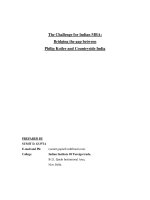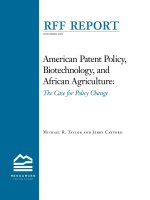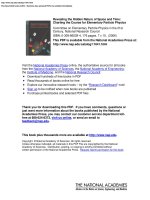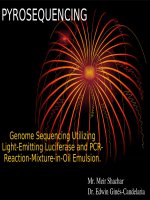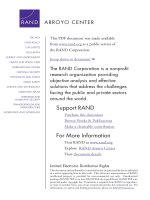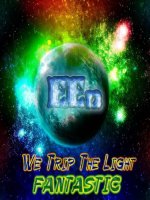Big Ideas and Understandings as the Foundartion for Elementary and Meddle School Mathematics
Bạn đang xem bản rút gọn của tài liệu. Xem và tải ngay bản đầy đủ của tài liệu tại đây (188.66 KB, 16 trang )
NCSM Journal • SPRING - SUMMER, 2005
Big Ideas and Understandings as the Foundation for
Elementary and Middle School Mathematics
Randall I. Charles, Carmel, CA
sion of their importance. Then a set of Big Ideas and
Understandings for elementary and middle school mathematics is proposed. The paper closes with some suggestions for ways Big Ideas can be used.
ducation has always been grounded on the principle that high quality teaching is directly linked to
high achievement and that high quality teaching
begins with the teacher’s deep subject matter
knowledge. Mathematics education in the United States
has been grounded on this principle, and most educators
and other citizens have always believed that our teachers
have adequate content knowledge given the high mathematics achievement of our students. Unfortunately, research
conducted in the past ten years has shown that the United
States is not among the highest achieving countries in the
world, and that our teacher’s subject matter knowledge
and teaching practices are fundamentally different than
those of teachers in higher achieving countries.
E
In working with colleagues on the development of this
paper I am rather certain that it is not possible to get one
set of Big Ideas and Understandings that all mathematicians
and mathematics educators can agree on. Fortunately, I do
not think it’s necessary to reach a consensus in this regard.
Use the Big Mathematical Ideas and Understandings presented here as a starting point for the conversations they
are intended to initiate.
What is a Big Idea in mathematics?
Research is beginning to identify important characteristics
of highly effective teachers (Ma 1999, Stigler 2004; Weiss,
Heck, and Shimkus, 2004). For example, effective teachers
ask appropriate and timely questions, they are able to
facilitate high-level classroom conversations focused on
important content, and they are able to assess students’
thinking and understanding during instruction. Another,
and the focus of this paper, is the grounding of a teacher’s
mathematics content knowledge and their teaching practices around a set of Big Mathematical Ideas (Big Ideas).
Teachers need to understand the big ideas of mathematics
and be able to represent mathematics as a coherent and
connected enterprise. (NCTM, 2000, p. 17)
Teachers are being encouraged more and more through
statements such as the one above to teach to the big ideas
of mathematics. Yet if you ask a group of teachers or any
group of mathematics educators for examples of big ideas,
you’ll get quite a variety of answers. Some will suggest a
topic, like equations, others will suggest a strand, like
geometry, others will suggest an expectation, such as those
found in Principles and Standards for School Mathematics
(NCTM, 2000), and some will even suggest an objective,
such as those found in many district and state curriculum
standards. Although all of these are important, none seems
sufficiently robust to qualify as a big idea in mathematics.
Below is a proposed definition of a big idea, and it is the
one that was used for the work shared in this paper.
The purpose of this paper is to initiate a conversation
about the notion of Big Ideas in mathematics. Although
Big Ideas have been talked about for some time, they have
not become part of mainstream conversations about
mathematics standards, curriculum, teaching, learning,
and assessment. Given the growing evidence as to their
importance, it is timely to start these conversations. A definition of a Big Idea is presented here along with a discus-
9
Journal of Mathematics Education Leadership, volume 7, number 3
NCSM Journal • SPRING - SUMMER, 2005
DEFINITION: A Big Idea is a statement of an
idea that is central to the learning of mathematics, one that links numerous mathematical
understandings into a coherent whole.
The third important component of the definition of a Big
Idea is that it links numerous mathematics understandings
into a coherent whole. Big Ideas make connections.1 As an
example, the early grades curriculum introduces several
“strategies” for figuring out basic number combinations
such as 5 + 6 and 6 x 7. The strategy of use a double
involves thinking that 5 + 6 is the same as 5 + 5 and 1
more. The strategy of use a five fact involves thinking that
6 x 7 is the same as 5 x 7 and 7 more. Both of these strategies, and others, are connected through the idea of equivalence; both involve breaking the calculation apart into an
equivalent representation that uses known facts to figure
out the unknown fact. Good teaching should make these
connections explicit.
There are several important components of this definition.
First, a Big Idea is a statement; here’s an example.
Any number, measure, numerical expression,
algebraic expression, or equation can be represented in an infinite number of ways that have
the same value.
For ease of discussion each Big Idea below is given a word
or phrase before the statement of the Big Idea (e.g.,
Equivalence). It is important to remember that this word
or phrase is a name for the Big Idea; it is not the idea itself.
Rather the Big Ideas are the statements that follow the name.
Articulating a Big Idea as a statement forces one to come to
grips with the essential mathematical meaning of that idea.
A set of Big Ideas for elementary and middle school are
given later in this paper. For each Big Idea examples of
mathematical understandings are given. A mathematical
understanding is an important idea students need to learn
because it contributes to understanding the Big Idea. Some
mathematical understandings for Big Ideas can be identified through a careful content analysis, but many must be
identified by “listening to students, recognizing common
areas of confusion, and analyzing issues that underlie that
confusion” (Schifter, Russell, and Bastable 1999, p. 25).
Research and classroom experience are important vehicles
for the continuing search for mathematical understandings.
The second important component of the definition of a
Big Idea given above is that it is an idea central to the
learning of mathematics. For example, there are many
mathematical concepts (e.g., number, equality, numeration) and there are many mathematical processes (e.g.,
solving linear equations using inverse operation and properties of equality) where understanding is grounded on
knowing that mathematical objects like numbers, expressions, and equations can be represented in different ways
without changing the value or solution, that is, equivalence.
Also, knowing the kinds of changes in representations that
maintain the same value or the same solution is a powerful
problem-solving tool.
Why are Big Ideas Important?
Big Ideas should be the foundation for one’s mathematics
content knowledge, for one’s teaching practices, and for
the mathematics curriculum. Grounding one’s mathematics content knowledge on a relatively few Big Ideas establishes a robust understanding of mathematics. Hiebert and
his colleagues say, “We understand something if we see
how it is related or connected to other things we know”
(1997, p. 4), and “The degree of understanding is determined by the number and strength of the connections”
(Hiebert & Carpenter, 1992, p. 67). Because Big Ideas have
connections to many other ideas, understanding Big Ideas
develops a deep understanding of mathematics. When one
understands Big Ideas, mathematics is no longer seen as a
set of disconnected concepts, skills, and facts. Rather,
mathematics becomes a coherent set of ideas. Also, understanding Big Ideas has other benefits.
Ideas central to the learning of mathematics can be identified in different ways. One way is through the careful
analysis of mathematics concepts and skills; a content
analysis that looks for connections and commonalities that
run across grades and topics. This approach was used to
develop the Big Ideas presented here drawing on the work
of others who have articulated ideas central to learning
mathematics (see e.g., NCTM 1989, 1992, 2000; O’Daffer
and others, 2005; Van de Walle 2001). Some additional
thoughts are given later about identifying Big Ideas.
1 This attribute of a big idea is consistent with definitions others have provided- see Clements & DiBiase 2001; Ritchhart 1999; Southwest
Consortium for the Improvement of Mathematics and Science Teaching 2002; Trafton & Reys, 2004.
10
Journal of Mathematics Education Leadership, volume 7, number 3
NCSM Journal • SPRING - SUMMER, 2005
As part of a Kindergarten through Grade 8 curriculum
development project, several colleagues and I articulated
“math understandings” for every lesson we wrote in the
program. Using the long list of math understandings we
created, I organized these across content strands rather
than grade levels. When I did that, it became apparent that
there were clusters of math understandings, ideas that
seem to be connected to something bigger. I then started
the process of trying to articulate what it was that connected these ideas; I developed my definition of a Big Idea
and used that as a guide. I next confronted a fundamental
issue in doing this kind of work — how big (or small) is a
Big Idea? Although I am not presumptuous enough to
suggest an answer to this question, I can share some thinking that guided me. My sense is that Big Ideas need to be
big enough that it is relatively easy to articulate several
related ideas, what I called mathematical understandings.
I also believe that Big Ideas need to be useful to teachers,
curriculum developers, test developers, and to those
responsible for developing state and district standards. If a
Big Idea is too big, my sense is that its usefulness for these
audiences diminishes. This thinking led to an initial list of
31 Big Ideas grouped into the traditional content strands.
Reviews by colleagues suggested that articulating Big Ideas
by content strands was not necessary; Big Ideas are BIG
because many run across strands. This led to a reduction
in the number of Big Ideas on my list. Further analyses of
my list with regard to their usefulness for the audiences
mentioned above led to the list offered in this paper.
Understanding:
• is motivating.
• promotes more understanding.
• promotes memory.
• influences beliefs.
• promotes the development of autonomous learners.
• enhances transfer.
• reduces the amount that must be remembered.
(Lambdin 2003).
Teachers who understand the Big Ideas of mathematics
translate that to their teaching practices by consistently
connecting new ideas to Big Ideas and by reinforcing Big
Ideas throughout teaching (Ma 1999). Also, effective teachers know how Big Ideas connect topics across grades; they
know the concepts and skills developed at each grade and
how those connect to previous and subsequent grades.
And finally, Big Ideas are important in building and using
curricula. The Curriculum Principle from the Principles and
Standards for School Mathematics (NCTM, 2000) gives
three attributes of a powerful curriculum.
1) A mathematics curriculum should be coherent.
2) A mathematics curriculum should focus on important
mathematics.
3) A mathematics curriculum should be well articulated
across the grades.
Finally, it is important to note that there are relatively few
Big Ideas in this list – this is what makes the notion of Big
Ideas so powerful. One’s content knowledge, teaching
practices, and curriculum can all be grounded on a small
number of ideas. This not only brings everything together
for the teacher but most importantly it enables students to
develop a deep understanding of mathematics.
The National Research Council reinforced these ideas
about curriculum: “…it is important that states and districts avoid long lists [of standards] that are not feasible
and that would contribute to an unfocused and shallow
mathematics curriculum” (2001, p. 35). By the definition
given above, Big Ideas provide curriculum coherence and
articulate the important mathematical ideas that should be
the focus of curriculum.
What are some ways Big Ideas can be used?
Here are a few ways that Big Mathematical Ideas and
Understandings can be used.
What are Big Ideas for elementary and
middle school mathematics?
Twenty-one (21) Big Mathematical Ideas for elementary
and middle school mathematics are given at the end of
this paper. Knowing the process I used to develop this list
and some issues I confronted in developing it might be
helpful if you decide to modify it or build your own.
Curriculum Standards and Assessment
• Revise/create district and state curriculum standards to
incorporate Big Mathematical Ideas and Understandings.
Many state standards emphasize mathematical skills.
Curriculum coherence and effective mathematics
instruction starts with standards that embrace not just
skills but also big mathematical ideas and understandings.
11
Journal of Mathematics Education Leadership, volume 7, number 3
NCSM Journal • SPRING - SUMMER, 2005
Appendix A shows an example of one way Big Ideas might
be infused into an existing curriculum. In this example,
the teachers did an analysis of all of the lessons in a fourth
grade chapter on multiplication. Based on that analysis,
they created a chapter overview that started with their
state content and reasoning standards but then connected
them to Big Ideas. Individual lessons were then connected
to the Standards and Big Ideas and to the specific mathematics understandings to be developed in that lesson.
• Develop individual teacher, district, state, or national
assessments around Big Mathematical Ideas and
Understandings. Alignment of standards and assessment
is important for many reasons and both need to address
big ideas, understandings, and skills.
Professional Development
• Build professional development courses focused on mathematics content and anchored on Big Ideas and
Understandings. Engage teachers with tasks that enable
them to grapple with Big Ideas and Understandings.
Conclusion
The purpose of this paper is to start a conversation about
Big Ideas. Use the Big Ideas and Math Understandings presented here as a starting point; edit, add, and delete as you
feel best. But, as you develop your own set keep these points
in mind. First, do not lose the essence of a Big Idea as
defined here, and second, do not allow your list of Big Ideas
and Understandings to balloon to a point where content and
curriculum coherence are lost. Big Ideas need to remain BIG
and they need to be the anchors for most everything we do.
• Do a lesson study where Big Ideas are used to connect
content and teaching practices (See Takahashi &
Yoshida, 2004).
• Develop chapter/unit and individual lesson plans by starting with Big Ideas. Generate mathematical understandings
specific to the content and grade level(s) of interest.
Big Mathematical Ideas and Understandings for
Elementary and Middle School Mathematics
A Big Idea is a statement of an idea that is central to the learning of mathematics, one that links numerous mathematical understandings into a coherent whole.
BIG IDEA #1
NUMBERS — The set of real numbers is infinite, and each real number can be associated with
a unique point on the number line.
Examples of Mathematical Understandings:
Counting Numbers
• Counting tells how many items there are altogether. When counting, the last number tells the total number of items;
it is a cumulative count.
• Counting a set in a different order does not change the total.
• There is a number word and a matching symbol that tell exactly how many items are in a group.
• Each counting number can be associated with a unique point on the number line, but there are many points on the
number line that cannot be named by the counting numbers.
• The distance between any two consecutive counting numbers on a given number line is the same.
• One is the least counting number and there is no greatest counting number on the number line.
• Numbers can also be used to tell the position of objects in a sequence (e.g., 3rd), and numbers can be used to name
something (e.g., social security numbers).
12
Journal of Mathematics Education Leadership, volume 7, number 3
NCSM Journal • fall - winter, 2004 - 2005
Whole Numbers
• Zero is a number used to describe how many are in a group with no objects in it.
• Zero can be associated with a unique point on the number line.
• Each whole number can be associated with a unique point on the number line, but there are many points on the number
line that cannot be named by the whole numbers.
• Zero is the least whole number and there is no greatest whole number on the number line.
Integers
• Integers are the whole numbers and their opposites on the number line, where zero is its own opposite.
• Each integer can be associated with a unique point on the number line, but there are many points on the number line
that cannot be named by integers.
• An integer and its opposite are the same distance from zero on the number line.
• There is no greatest or least integer on the number line.
Fractions/Rational Numbers
• A fraction describes the division of a whole (region, set, segment) into equal parts.
• The bottom number in a fraction tells how many equal parts the whole or unit is divided into. The top number tells how
many equal parts are indicated.
• A fraction is relative to the size of the whole or unit.
ã A fraction describes division.( a/b = a ữ b, a & b are integers & b ≠ 0), and it can be interpreted on the number line in
two ways. For example, 2/3 = 2 ÷ 3. On the number line, 2 ÷ 3 can be interpreted as 2 segments where each is 1/3
of a unit (2 x 1/3) or 1/3 of 2 whole units (1/3 x 2); each is associated with the same point on the number line.
(Rational number)
• Each fraction can be associated with a unique point on the number line, but not all of the points between integers can
be named by fractions.
• There is no least or greatest fraction on the number line.
• There are an infinite number of fractions between any two fractions on the number line.
• A decimal is another name for a fraction and thus can be associated with the corresponding point on the number line.
• Whole numbers and integers can be written as fractions (e.g., 4 = 4/1, -2 = -8/4).
• A percent is another way to write a decimal that compares part to a whole where the whole is 100 and thus can be
associated with the corresponding point on the number line.
• Percent is relative to the size of the whole.
BIG IDEA #2
THE BASE TEN NUMERATION SYSTEM — The base ten numeration system is a scheme for
recording numbers using digits 0-9, groups of ten, and place value.
Examples of Mathematical Understandings:
Whole Numbers
• Numbers can be represented using objects, words, and symbols.
• For any number, the place of a digit tells how many ones, tens, hundreds, and so forth are represented by that digit.
• Each place value to the left of another is ten times greater than the one to the right (e.g., 100 = 10 x 10).
• You can add the value of the digits together to get the value of the number.
• Sets of ten, one hundred and so forth must be perceived as single entities when interpreting numbers using place value
(e.g., 1 hundred is one group, it is 10 tens or 100 ones).
13
Journal of Mathematics Education Leadership, volume 7, number 3
NCSM Journal • SPRING - SUMMER, 2005
Decimals
• Decimal place value is an extension of whole number place value.
• The base-ten numeration system extends infinitely to very large and very small numbers (e.g., millions & millionths).
BIG IDEA #3
EQUIVALENCE: Any number, measure, numerical expression, algebraic expression, or equation
can be represented in an infinite number of ways that have the same value.
Examples of Mathematical Understandings:
Numbers and Numeration
• Numbers can be decomposed into parts in an infinite number of ways
• Numbers can be named in equivalent ways using place value (e.g., 2 hundreds 4 tens is equivalent to 24 tens).
• Numerical expressions can be named in an infinite number of different but equivalent ways (e.g., 4/6 ÷ 2/8 = 2/3 ÷
1/4 = 2/3 x 4/1; also 26 x 4 = (20 + 6) x 4).
• Decimal numbers can be named in an infinite number of different but equivalent forms (e.g., 0.3 = 0.30 = 0.10 + 0.20).
Number Theory and Fractions
• Every composite number can be expressed as the product of prime numbers in exactly one way, disregarding the order
of the factors (Fundamental Theorem of Arithmetic).
• Every fraction/ratio can be represented by an infinite set of different but equivalent fractions/ratios.
Algebraic Expressions and Equations
• Algebraic expressions can be named in an infinite number of different but equivalent ways (e.g., 2(x – 12) = 2x – 24 =
2x – (28 - 4)).
• A given equation can be represented in an infinite number of different ways that have the same solution (e.g., 3x – 5 =
16 and 3x = 21 are equivalent equations; they have the same solution, 7).
Measurement
• Measurements can be represented in equivalent ways using different units (e.g., 2 ft 3 in = 27 in.).
• A given time of day can be represented in more than one way.
• For most money amounts, there are different, but finite combinations of currency that show the same amount; the number
of coins in two sets does not necessarily indicate which of two sets has the greater value.
BIG IDEA #4
COMPARISON: Numbers, expressions, and measures can be compared by their relative values.
Examples of Mathematical Understandings:
Numbers & Expressions
• One-to-one correspondence can be used to compare sets.
• A number to the right of another on the number line is the greater number.
• Numbers can be compared using greater than, less than, or equal.
• Three or more numbers can be ordered by repeatedly doing pair-wise comparisons.
• Whole numbers and decimals can be compared by analyzing corresponding place values.
• Numerical and algebraic expressions can be compared using greater than, less than, or equal.
14
Journal of Mathematics Education Leadership, volume 7, number 3
NCSM Journal • SPRING - SUMMER, 2005
Fractions, Ratios, & Percent
• A comparison of a part to the whole can be represented using a fraction.
• A ratio is a multiplicative comparison of quantities; there are different types of comparisons that can be represented
as ratios.
• Ratios give the relative sizes of the quantities being compared, not necessarily the actual sizes.
• Rates are special types of ratios where unlike quantities are being compared.
• A percent is a special type of ratio where a part is compared to a whole and the whole is 100.
• The probability of an event is a special type of ratio.
Geometry and Measurement
• Lengths can be compared using ideas such as longer, shorter, and equal.
• Mass/weights can be compared using ideas such as heavier, lighter, and equal.
• Measures of area, volume, capacity and temperature can each be compared using ideas such as greater than, less
than, and equal.
• Time duration for events can be compared using ideas such as longer, shorter, and equal.
• Angles can be compared using ideas such as greater than, less than, and equal.
BIG IDEA #5
OPERATION MEANINGS & RELATIONSHIPS: The same number sentence (e.g. 12-4 = 8) can
be associated with different concrete or real-world situations, AND different number sentences can be associated with the same concrete or real-world situation.
Examples of Mathematical Understandings:
Whole Numbers
• Some real-world problems involving joining, separating, part-part-whole, or comparison can be solved using addition;
others can be solved using subtraction.
• Adding x is the inverse of subtracting x.
• Any subtraction calculation can be solved by adding up from the subtrahend.
• Adding quantities greater than zero gives a sum that’s greater than any addend.
• Subtracting a whole number (except 0) from another whole number gives a difference that’s less than the minuend.
• Some real-world problems involving joining equal groups, separating equal groups, comparison, or combinations can
be solved using multiplication; others can be solved using division.
• Multiplying by x is the inverse of dividing by x.
• Any division calculation can be solved using multiplication.
• Multiplying two whole numbers greater than one gives a product greater than either factor.
Rational Numbers (Fractions & Decimals)
• The real-world actions for addition and subtraction of whole numbers are the same for operations with fractions
and decimals.
• Different real-world interpretations can be associated with the product of a whole number and fraction (decimal),
a fraction (decimal) and whole number, and a fraction and fraction (decimal and decimal).
• Different real-world interpretations can be associated with division calculations involving fractions (decimals).
• The effects of operations for addition and subtraction with fractions and decimals are the same as those with
whole numbers.
• The product of two positive fractions each less than one is less than either factor.
15
Journal of Mathematics Education Leadership, volume 7, number 3
NCSM Journal • SPRING - SUMMER, 2005
Integers
• The real-world actions for operations with integers are the same for operations with whole numbers.
BIG IDEA #6
PROPERTIES: For a given set of numbers there are relationships that are always true, and
these are the rules that govern arithmetic and algebra.
Examples of Mathematical Understandings:
Properties of Operations
• Properties of whole numbers apply to certain operations but not others (e.g., The commutative property applies to addition and multiplication but not subtraction and division.).
• Two numbers can be added in any order; two numbers can be multiplied in any order.
• The sum of a number and zero is the number; the product of any non-zero number and one is the number.
• Three or more numbers can be grouped and added (or multiplied) in any order.
Properties of Equality
• If the same real number is added or subtracted to both sides of an equation, equality is maintained.
• If both sides of an equation are multiplied or divided by the same real number (not dividing by 0), equality is maintained.
• Two quantities equal to the same third quantity are equal to each other.
BIG IDEA #7
BASIC FACTS & ALGORITHMS: Basic facts and algorithms for operations with rational numbers
use notions of equivalence to transform calculations into simpler ones.
Examples of Mathematical Understandings:
Mental Calculations
• Number relationships and sequences can be used for mental calculations (one more, one less; ten more, ten less;
30 is two more than 28; counting back by thousands from 50,000 is 49,000, 48,000, 47,000 etc.)
• Numbers can be broken apart and grouped in different ways to make calculations simpler.
Whole Number Basic Facts & Algorithms
• Some basic addition and multiplication facts can be found by breaking apart the unknown fact into known facts. Then
the answers to the known facts are combined to give the final value.
• Subtraction facts can be found by thinking of the related addition fact.
• Division facts can be found by thinking about the related multiplication fact.
• When 0 is divided by any non-zero number, the quotient is zero, and 0 cannot be a divisor.
• Addition can be used to check subtraction, and multiplication can be used to check division.
• Powers of ten are important benchmarks in our numeration system, and thinking about numbers in relation to powers of
ten can make addition and subtraction easier.
• When you divide whole numbers sometimes there is a remainder; the remainder must be less than the divisor.
• The real-world situation determines how a remainder needs to be interpreted when solving a problem.
Rational Number Algorithms
• Fractions with unlike denominators are renamed as equivalent fractions with like denominators to add and subtract.
• The product of two fractions can be found by multiplying numerators and multiplying denominators.
16
Journal of Mathematics Education Leadership, volume 7, number 3
NCSM Journal • SPRING - SUMMER, 2005
• A fraction division calculation can be changed to an equivalent multiplication calculation (i.e., a/b ÷ c/d = a/b x d/c,
where b, c, and d = 0).
• Division with a decimal divisor is changed to an equivalent calculation with a whole number divisor by multiplying the
divisor and dividend by an appropriate power of ten.
• Money amounts represented as decimals can be added and subtracted using the same algorithms as with whole numbers.
Measurement
• Algorithms for operations with measures are modifications of algorithms for rational numbers.
• Length measurements in feet and inches can be added or subtracted where 1 foot is regrouped as 12 inches.
• Times in minutes and seconds can be added and subtracted where 1 minute is regrouped as 60 seconds.
BIG IDEA #8
ESTIMATION: Numerical calculations can be approximated by replacing numbers with other
numbers that are close and easy to compute with mentally. Measurements can be approximated using known referents as the unit in the measurement process.
Examples of Mathematical Understandings:
Numerical
• The numbers used to make an estimate determine whether the estimate is over or under the exact answer.
• Division algorithms use numerical estimation and the relationship between division and multiplication to find quotients.
• Benchmark fractions like 1/2 (0.5) and 1/4 (0.25) can be used to estimate calculations involving fractions and decimals.
• Estimation can be used to check the reasonableness of exact answers found by paper/pencil or calculator methods.
Measurement
• Length, area, volume, and mass/weight measurements can be estimated using appropriate known referents.
• A large number of objects in a given area can be estimated by finding how many are in a sub-section and multiplying by
the number of sub-sections.
BIG IDEA #9
PATTERNS: Relationships can be described and generalizations made for mathematical
situations that have numbers or objects that repeat in predictable ways.
Examples of Mathematical Understandings:
Numbers
• Skip counting on the number line generates number patterns.
• The structure of the base ten numeration system produces many numerical patterns.
• There are patterns in the products for multiplication facts with factors of 0, 1, 2, 5, and 9.
• There are patterns when multiplying or dividing whole numbers and decimals by powers of ten.
• The difference between successive terms in some sequences is constant.
• The ratio of successive terms in some sequences is a constant.
• Known elements in a pattern can be used to predict other elements.
Geometry
• Some sequences of geometric objects change in predictable ways.
17
Journal of Mathematics Education Leadership, volume 7, number 3
NCSM Journal • SPRING - SUMMER, 2005
BIG IDEA #10
VARIABLE: Mathematical situations and structures can be translated and represented
abstractly using variables, expressions, and equations.
Examples of Mathematical Understandings:
• Letters are used in mathematics to represent generalized properties, unknowns in equations, and relationships between
quantities.
• Some mathematical phrases can be represented as algebraic expressions (e.g. Five less than a number can be written
as n – 5.)
• Some problem situations can be represented as algebraic expressions (e.g. Susan is twice as tall as Tom; If T = Tom’s
height, then 2T = Susan’s height.)
• Algebraic expressions can be used to generalize some transformations of objects in the plane.
BIG IDEA #11
PROPORTIONALITY: If two quantities vary proportionally, that relationship can be represented
as a linear function.
Examples of Mathematical Understandings:
• A ratio is a multiplicative comparison of quantities.
• Ratios give the relative sizes of the quantities being compared, not necessarily the actual sizes.
• Ratios can be expressed as units by finding an equivalent ratio where the second term is one.
• A proportion is a relationship between relationships.
• If two quantities vary proportionally, the ratio of corresponding terms is constant.
• If two quantities vary proportionally, the constant ratio can be expressed in lowest terms (a composite unit) or as a unit
amount; the constant ratio is the slope of the related linear function.
• There are several techniques for solving proportions (e.g., finding the unit amount, cross products).
• When you graph the terms of equal ratios as ordered pairs (first term, second term) and connect the points, the graph
is a straight line.
• If two quantities vary proportionally, the quantities are either directly related (as one increases the other increases) or
inversely related (as one increases the other decreases).
• Scale drawings involve similar figures, and corresponding parts of similar figures are proportional.
• In any circle, the ratio of the circumference to the diameter is always the same and is represented by the number pi.
• Rates can be related using proportions as can percents and probabilities.
BIG IDEA #12
RELATIONS & FUNCTIONS: Mathematical rules (relations) can be used to assign members of
one set to members of another set. A special rule (function) assigns each member of one set
to a unique member of the other set.
Examples of Mathematical Understandings:
• Mathematical relationships can be represented and analyzed using words, tables, graphs, and equations.
• In mathematical relationships, the value for one quantity depends on the value of the other quantity.
• The nature of the quantities in a relationship determines what values of the input and output quantities are reasonable.
• The graph of a relationship can be analyzed with regard to the change in one quantity relative to the change in the
other quantity.
18
Journal of Mathematics Education Leadership, volume 7, number 3
NCSM Journal • SPRING - SUMMER, 2005
• The graph of a relation can be analyzed to determine if the relation is a function.
• In a linear function of the form y = ax, a is the constant of variation and it represents the rate of change of y with
respect to x.
• The solutions to a linear function form a straight line when graphed.
• A horizontal line has a slope of 0, and a vertical line does not have a slope.
• The parameters in an equation representing a function affect the graph of the function in predictable ways.
BIG IDEA #13
EQUATIONS & INEQUALITIES: Rules of arithmetic and algebra can be used together with
notions of equivalence to transform equations and inequalities so solutions can be found.
Examples of Mathematical Understandings:
• A solution to an equation is a value of the unknown or unknowns that makes the equation true.
• Properties of equality and reversible operations can be used to generate equivalent equations and find solutions.
• Techniques for solving equations start by transforming the equation into an equivalent one.
• A solution or solutions to a linear or quadratic equation can be found in the table of ordered pairs or from the graph of
the related function.
• Techniques for solving equations can be applied to solving inequalities, but the direction of the inequality sign needs to
be considered when negative numbers are involved.
BIG IDEA #14
SHAPES & SOLIDS: Two- and three-dimensional objects with or without curved surfaces can
be described, classified, and analyzed by their attributes.
Examples of Mathematical Understandings:
• Point, line, line segment, and plane are the core attributes of space objects, and real-world situations can be used to
think about these attributes.
• Polygons can be described uniquely by their sides and angles.
• Polygons can be constructed from or decomposed into other polygons.
• Triangles and quadrilaterals can be described, categorized, and named based on the relative lengths of their sides and
the sizes of their angles.
• All polyhedra can be described completely by their faces, edges, and vertices.
• Some shapes or combinations of shapes can be put together without overlapping to completely cover the plane.
• There is more than one way to classify most shapes and solids.
BIG IDEA #15
ORIENTATION & LOCATION: Objects in space can be oriented in an infinite number of ways,
and an object’s location in space can be described quantitatively.
Examples of Mathematical Understandings:
Lines and Line Segments
• Two distinct lines in the plane are either parallel or intersecting; two distinct lines in space are parallel, intersecting
or skew.
• The angles formed by two intersecting lines in the plane are related in special ways (e.g., vertical angles).
• A number of degrees can be used to describe the size of an angle’s opening.
19
Journal of Mathematics Education Leadership, volume 7, number 3
NCSM Journal • SPRING - SUMMER, 2005
• Some angles have special relationships based on their position or measures (e.g., complementary angles).
• In the plane, when a line intersects two parallel lines the angles formed are related in special ways.
Objects
• The orientation of an object does not change the other attributes of the object.
• The Cartesian Coordinate System is a scheme that uses two perpendicular number lines intersecting at 0 on each to
name the location of points in the plane; the system can be extended to name points in space.
• Every point in the plane can be described uniquely by an ordered pair of numbers; the first number tells the distance to
the left or right of zero on the horizontal number line; the second tells the distance above or below zero on the vertical
number line.
BIG IDEA #16
TRANSFORMATIONS: Objects in space can be transformed in an infinite number of ways, and
those transformations can be described and analyzed mathematically.
Examples of Mathematical Understandings:
• Congruent figures remain congruent through translations, rotations, and reflections.
• Shapes can be transformed to similar shapes (but larger or smaller) with proportional corresponding sides and
congruent corresponding angles
• Algebraic expressions can be used to generalize transformations for objects in the plane.
• Some shapes can be divided in half where one half folds exactly on top of the other (line symmetry).
• Some shapes can be rotated around a point in less than one complete turn and land exactly on top of themselves (rotational symmetry).
BIG IDEA #17
MEASUREMENT: Some attributes of objects are measurable and can be quantified using unit
amounts.
Examples of Mathematical Understandings:
• Measurement involves a selected attribute of an object (length, area, mass, volume, capacity) and a comparison of the
object being measured against a unit of the same attribute.
• The longer the unit of measure, the fewer units it takes to measure the object.
• The magnitude of the attribute to be measured and the accuracy needed determines the appropriate measurement unit.
• For a given perimeter there can be a shape with area close to zero. The maximum area for a given perimeter and a
given number of sides is the regular polygon with that number of sides.
BIG IDEA #18
DATA COLLECTION: Some questions can be answered by collecting and analyzing data, and
the question to be answered determines the data that needs to be collected and how best
to collect it.
Examples of Mathematical Understandings:
• An appropriately selected sample can be used to describe and make predictions about a population.
• The size of a sample determines how close data from the sample mirrors the population.
20
Journal of Mathematics Education Leadership, volume 7, number 3
NCSM Journal • SPRING - SUMMER, 2005
BIG IDEA #19
DATA REPRESENTATION: Data can be represented visually using tables, charts, and graphs.
The type of data determines the best choice of visual representation.
Examples of Mathematical Understandings:
• Each type of graph is most appropriate for certain types of data.
• Scale influences the patterns that can be observed in data.
BIG IDEA #20
DATA DISTRIBUTION: There are special numerical measures that describe the center and
spread of numerical data sets.
Examples of Mathematical Understandings:
• The best descriptor of the center of a numerical data set (i.e., mean, median, mode) is determined by the nature of the
data and the question to be answered.
• Outliers affect the mean, median, and mode in different ways.
• Data interpretation is enhanced by numerical measures telling how data are distributed.
BIG IDEA #21
CHANCE: The chance of an event occurring can be described numerically by a number
between 0 and 1 inclusive and used to make predictions about other events.
Examples of Mathematical Understandings:
• Probability can provide a basis for making predictions.
• Some probabilities can only be determined through experimental trials.
• An event that is certain to happen will always happen (The probability is 1.) and an event that is impossible will never
happen (The probability is 0.).
21
Journal of Mathematics Education Leadership, volume 7, number 3
NCSM Journal • SPRING - SUMMER, 2005
APPENDIX A:
A Sample Chapter Analysis Using Standards and Big Ideas
GRADE 3
CHAPTER 9: MULTIPLYING GREATER NUMBERS
CONTENT STANDARDS
Discussion
Focus
*NS 2.4: Solve simple problems involving multiplication of
multi-digit numbers by one-digit numbers
NS 2.4, Multiplying multi-digit numbers by 1-digit numbers, is
the main focus of this chapter. Multiplicands up to four digits
are used including money amounts such as $43.98. The standard algorithm is developed with whole numbers and extended
to money. All decimal quantities are related to money amounts.
Other
*NS 3.3: Solve problems involving operations with money
amounts in decimal notation and multiply and divide money
amounts in decimal notation using whole number multipliers
and divisors
BIG IDEAS
Discussion
Focus
+ Algorithms: Algorithms for operations with rational numbers
use notions of equivalence to transform calculations into simpler ones.
The Big Idea of focus is Algorithms and it should be emphasized in every skill lesson. All calculations in this chapter
involve changing the numerical expression to an equivalent one
and breaking the calculation into simpler ones involving basic
facts or 1-digit numbers times a multiple of 10, or 100. Lesson
9-1 develops the simpler calculations one needs to know for
the other skill lessons in the chapter.
+ Operation Meanings & Relationships: The same number
sentence can be associated with different concrete or realworld situations, AND different number sentences can be
associated with the same concrete or real-world situation.
The array interpretation of multiplication is used to show how
the standard algorithm involves breaking the calculation into
simpler ones. The distributive property justifies the breaking
apart process. For example, 3 x 15 = 3 x (10 + 5) = (3 x 10) +
(3 x 5) = 30 + 5 = 35. Notice that 15 is named in an equivalent way, 10 + 5.
+ Properties: For a given set of numbers there are relationships that are always true, and these are the rules that govern
arithmetic and algebra.
Other
+ Equivalence: Any number, measure, numerical expression,
algebraic expression, or equation can be represented in an
infinite number of ways that have the same value.
MATHEMATICAL REASONING
Discussion
Focus
MR 1.1 Analyze problems by identifying relationships, and so
forth
Estimating products, developed in 9-4, should be emphasized
in every lesson thereafter. Rounding might be used most often
but compatible numbers also can be used (e.g., 2 x 36 is
about 2 x 35). The need for exact or approximate answers
should be discussed.
MR 2.1 Use estimation to verify the reasonableness of results
MR 2.2 Apply strategies and results from simpler problems to
more complex problems.
Operation meanings should be emphasized. The repeated
addition and array interpretations are emphasized throughout
the chapter.
Other
MR 2.3 – 2.6, 3.0
The Big Idea of Algorithms connects to MR 2.2, breaking a
problem into simpler ones. This applies to the multiplication
algorithm and to solving some types of word problems.
Students should generalize the multiplication process from
2-digit through 4-digit multiplicands; the process is the same,
it is just repeated.
22
Journal of Mathematics Education Leadership, volume 7, number 3
NCSM Journal • SPRING - SUMMER, 2005
References
Annenberg/CPB. (2004) Learning Math: Five College-Level Mathematics Courses for Elementary and Middle School
Teachers. Available at learner.org/channel/courses/learningmath/index as of June 2004.
Clements, D. & DiBiase, A-M. (2001) Guidelines for Early Childhood Mathematics. Intersection, Exxon Mobil Foundation
and the National Council of Teachers of Mathematics. September 2001 issue. Available at intersectionlive.org/index
as of June 2004.
Hiebert, J. & Carpenter, T. P. (1992) Learning and Teaching with Understanding. In Handbook of Research on Mathematics
Teaching and Learning, edited by Douglas A. Grouws. New York: Macmillan. 65-97.
Hiebert, J., Carpenter, T.P., Fennema, E., Fuson, K., Wearne, D., Murray, H., Olivier, A., & Human, P. (1997). Making Sense:
Teaching and Learning Mathematics with Understanding. Portsmouth, NH: Heinemann.
Lambdin, D. (2003). Benefits of Teaching through Problem Solving. In Teaching Mathematics Through Problem Solving:
Grades PreK-6, edited by Frank K. Lester Jr. and Randall I. Charles. Reston, VA: National Council of Teachers of
Mathematics. 3-14.
Ma, L. (1999). Knowing and Teaching Elementary Mathematics: Teachers' Understanding of Fundamental Mathematics in
China and the United States. Mahwah, N.J.: Lawrence Erlbaum.
National Council of Teachers of Mathematics (1969) Historical Topics for the Mathematics Classroom. Washington, D.C.: NCTM.
__________ (1989) Research Issues in the Learning and Teaching of Algebra. Edited by Sigrid Wagner and Carolyn Kieran.
Reston, VA: NCTM.
__________ (1992) Handbook of Research on Mathematics Teaching and Learning. Edited by Douglas A. Grouws. New
York: Macmillan Publishing.
__________ (2000) Principles and Standards for School Mathematics. Reston, VA: NCTM.
National Research Council (1990) On the Shoulders of Giants: New Approaches to Numeracy. Edited by Lynn Arthur Steen.
Washington, D.C.: National Academy Press.
__________ (2001) Adding it up: Helping Children Learn Mathematics. Edited by Jeremy Kilpatrick, Jane Swafford, and
Bradford Findell. Washington, D.C.: National Academy Press.
O’Daffer, P., Charles, R., Cooney, T., Dossey, J., and Schielack, J. (2005). Mathematics for Elementary School Teachers. 3rd
ed. Boston: Addison Wesley.
Ritchhart, R. (1999) Generative Topics: Building a Curriculum Around Big Ideas. Teaching Children Mathematics 5. 462-68.
Schifter, D., Russell, S.J., & Bastable, V. (1999) Teaching to the Big Ideas. In The Diagnostic Teacher: Constructing New
Approaches to Professional Development, edited by Mildred Z. Solomon. New York, New York: Teachers College
Press. 22-47.
Southwest Consortium for the Improvement of Mathematics and Science Teaching. (2002) Getting to the Heart of the
(Subject) Matter. Classroom Compass. September issue. Available at sedl.org/scimast as of June 2004.
23
Journal of Mathematics Education Leadership, volume 7, number 3
NCSM Journal • SPRING - SUMMER, 2005
Stigler, J. (2004) The Teaching Gap: Reflections on Mathematics Teaching and How to Improve It. Paper presented at the
Pearson National Educational Leadership Conference, Washington, D.C., March 2004.
Takahashi, A. & Yoshida, M. (2004) Ideas for Establishing Lesson-Study Communities. Teaching Children Mathematics 10.
436-443.
Trafton, P. R. & Reys, B.J. (2004) Standards-Based Mathematics Curriculum Materials: A Phrase in Search of a Definition.
Phi Delta Kappan. Available at pdkintl.org/kappan/k0111tra.htm as of June 2004.
Van de Walle, J. A. (2001) Elementary and Middle School Mathematics: Teaching Developmentally. 4th ed. New York: Longman.
Weiss, I. R., Heck, D.J., & Shimkus, E.S. (2004) Mathematics Teaching in the United States. Journal of Mathematics
Education Leadership 7. 23-32.
24
Journal of Mathematics Education Leadership, volume 7, number 3

